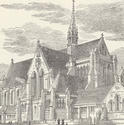 This was the heyday of the building of places of worship in Glasgow. Protestant denominations split and recombined and Gaelic-speaking, Catholic, Anglican and Jewish immigrants all sought their own sanctuaries and synagogues. The contribution these made to the cityscape is often critical to sense of place. The dominant style for such buildings is Gothic, but there were also many Classical places of worship, and some Romanesque. Until the 1890s most were constructed of cream sandstone, but from then until 1914 red sandstones were generally used.
This was the heyday of the building of places of worship in Glasgow. Protestant denominations split and recombined and Gaelic-speaking, Catholic, Anglican and Jewish immigrants all sought their own sanctuaries and synagogues. The contribution these made to the cityscape is often critical to sense of place. The dominant style for such buildings is Gothic, but there were also many Classical places of worship, and some Romanesque. Until the 1890s most were constructed of cream sandstone, but from then until 1914 red sandstones were generally used.
 The most prolific builders were the Presbyterian denominations, the Scottish Episcopal and the Catholic churches, but other Protestant denominations were also well represented, though some only by a single building. The most numerous and obviously dramatic group were the steepled Gothic churches, influenced by A. W. N. Pugin's assertion that Gothic was the only true Christian style. Striking groups can still be seen in Great Western Road and in Queen's Park. Alexander "Greek" Thomson's Classical St Vincent Street and Caledonia Road churches are masterly landmarks. Other distinctive and striking Classical buildings include Wellington, Elgin Place Congregational (now a nightclub) and Westbourne (now Struthers Memorial). The Romanesque places of worship include Garnethill Synagogue, Holy Cross Catholic Church, Crosshill, and Merrylea Parish Church. Not all Gothic buildings have steeples. Fine examples include Hyndland (designed with a steeple), Kelvinside, Hillhead, and the Barony (now a graduation hall). Pugin and Pugin's large Catholic churches are all of this type. All merit further study and appreciation.
The most prolific builders were the Presbyterian denominations, the Scottish Episcopal and the Catholic churches, but other Protestant denominations were also well represented, though some only by a single building. The most numerous and obviously dramatic group were the steepled Gothic churches, influenced by A. W. N. Pugin's assertion that Gothic was the only true Christian style. Striking groups can still be seen in Great Western Road and in Queen's Park. Alexander "Greek" Thomson's Classical St Vincent Street and Caledonia Road churches are masterly landmarks. Other distinctive and striking Classical buildings include Wellington, Elgin Place Congregational (now a nightclub) and Westbourne (now Struthers Memorial). The Romanesque places of worship include Garnethill Synagogue, Holy Cross Catholic Church, Crosshill, and Merrylea Parish Church. Not all Gothic buildings have steeples. Fine examples include Hyndland (designed with a steeple), Kelvinside, Hillhead, and the Barony (now a graduation hall). Pugin and Pugin's large Catholic churches are all of this type. All merit further study and appreciation.